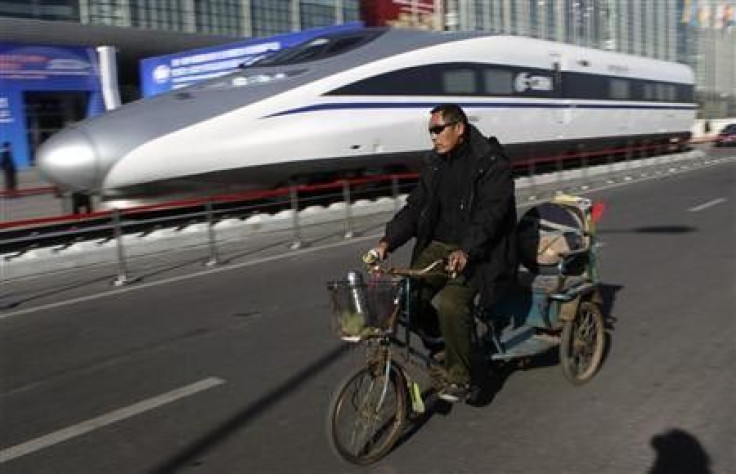China plans to spend big on nuclear power, high-speed rail

Nuclear power and high speed rail will top the focus of China's plan to invest $1.5 trillion in seven key industries and shift the world's number two economy away from its role as a supplier of cheap goods, sources said.
State-owned enterprises, rather than the government, will play the main role of channeling the investment, said one source with ties to the leadership.
China envisages high-end equipment manufacturing, including high-speed rail and aviation equipment, becoming a pillar of economic growth alongside energy-saving and environmentally friendly technologies, biotechnology and new generation information technology such as telecoms and the Internet.
The other strategic sectors are alternative energy, advanced materials and alternative-fuel cars.
China needs to innovate if it is to compete against multinationals in the international arena, said Qiu Gang of the Beijing office of Samsung Economic Research Institute.
China hopes to become an industrial giant by 2015.
It is that push by emerging economies, and China in particular, into high-end manufacturing that was seen as behind U.S. President Barack Obama's call in his speech to Congress last week for a Sputnik moment, fed by spending in education and research, to make sure the United States does not lose its technological edge.
A source with ties to the leadership told Reuters in December that the State Council, or cabinet, is considering investing up to $1.5 trillion in the sectors. The government has not publicly stated any figure.
The amount is part of a 2011-2015 five-year plan which needs approval the National People's Congress, or parliament, which holds its annual full session in March.
Analysts have expressed skepticism over the size of the investment which equates to about 5 percent of China's gross domestic product on an annual basis.
But they say it is an indication of the government's determination to force a structural shift in the economy.
A second source with leadership ties dismissed the doubts and said nuclear energy and high-speed rail would be the flavor of the decade, rather than wind or solar power.
State-owned enterprises will play the leading role, the source said, requesting anonymity due to sensitivities.
The private investors will be given incentives such as tax breaks and low interest bank loans, with national and local governments chipping in.
The government is expected to unveil preferential policies later this year, possibly allowing private enterprises to use intellectual property rights as collateral to obtain loans.
HIGH-SPEED RAIL
The cabinet spokesman's office and parliament, reached by telephone, declined to comment.
China's high-speed rail network has been developing rapidly over the past decade, reaching a total of 8,358 km (5,182 miles), the world's longest.
The government plans to invest up to 4 trillion yuan in high-speed rail between 2011 and 2015, according to the China Securities Journal.
During Chinese President Hu Jintao's U.S. visit in January, General Electric Co signed a deal to bring Chinese high-speed rail technology to the United States, and for GE to manufacture locomotives for China.
A spending spree on railways was an important part of China's 2008-2010 stimulus package.
NUCLEAR POWER
China has lumped nuclear, solar and wind energy in one group as new, or alternative, energy.
China had just 10.8 gigawatts of nuclear power capacity at end-2010. The official nuclear target for 2020 of 40 GW is still less than 5 percent of its current installed electricity generating capacity.
However, officials said that goal is likely to be raised to 80 GW or more for 2020.
The National Development and Reform Commission, the country's powerful economic planner, has said that the wind-power industry is already suffering from overcapacity.
And last week, the Ministry of Industry and Information Technology warned against blindly pursuing the development of new strategic sectors.
R&D INVESTMENT
Nomura International (HK) Ltd said in a research paper that the five-year plan could give boost research and development investment by over 4 trillion yuan.
The re-industrialization is designed to move China away from an export-industrial model to a domestically focused one, Nomura said.
This will not be all through cash disbursements but achieved by tax credits, privileged import tariff reductions and presumably easier credit and trade finance terms.
R&D spending currently accounts for 1.5 percent of GDP in China. That figure is expected to increase to 2.0-2.5 percent over the next five years, Nomura said.
The value-added output of the seven strategic industries together account for about 2 percent of GDP now. The government has said it wants them to generate 8 percent of GDP in 2015 and 15 percent by 2020.
By pushing these sectors, China would be making a big bet that technology can help bridge the gap between limited supplies of commodities and the rapidly growing demand that has propelled it to become the world's second-biggest economy.
© Copyright Thomson Reuters 2024. All rights reserved.











